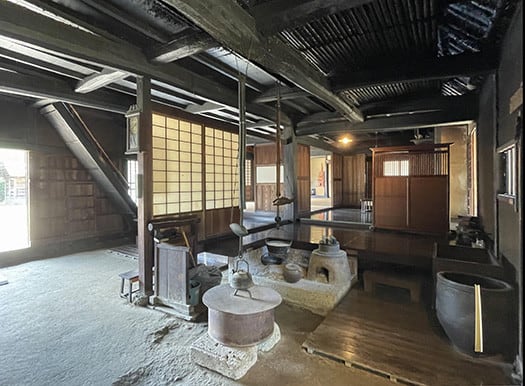



幕末から明治に掛けて、横浜からは生糸製品が多いに出荷された。
欧米の資本市場からはアジアからの出荷拡大が望まれたのだ。
識字率も高く、勤勉な国民性をもつ日本というあらたな世界市場参加者は
世界の資本主義市場のさまざまな分野で期待された。
南伊予での「木蝋」生産と神戸港からの貿易出荷は巨大な成功者を生み出した。
かれらは故郷に錦を飾るかのように建築道楽に湯水のごとく投資した。
同様に横浜からの輸出では生糸製品が脚光を浴びた。
日本は欧米列強による植民地化から逃れていたけれど
しかし不平等な条約のくびきには置かれていた。
江戸の支配権力機構には世界の資本主義的経済への対応戦略が欠けていた。
植民地にまでしなくても条約面で2等国扱いをできれば
独立の態を取らせてもいいかと欧米列強は考えたのに違いない。
それでもアジアの国のなかでこういうスタンスを取れたのは日本だけ。
明治開国のこの状況から、日本人は必死に坂の上の雲を追う努力を始めた。
こういう後追い型の発展では急成長が可能になるとされる。
目標とその手段が明確ならば、低賃金で勤勉な国民は強い競争力の源泉。
明治の日本国家は欧米を追いかけてキャッチアップを始める。
たぶん戦後の敗戦・焼け野原からとよく似た急成長があったのだ。
この時期の新興の日本人資本家たちは「こういう成功もあるのか」と
心の底から驚いたことだろう。それまでの封建の社会では
成功とは賄賂などで権力と結びついて権益確保を図るしかなかったものが、
貿易・産業構築によって成功を得ることができる、
資本主義というまったく未知の新ルールの世界が広がったということ。
住宅の世界では北海道開拓においてアメリカの住宅類型が導入された。
開拓期北海道は地域としてそうした欧米住文化の巨大展示場だった。
一方でこの群馬県赤城山麓地域では既存の住環境に大きな革新が働いた。
世界市場参入によって活発化する養蚕業にジャストフィットすべく
養蚕農家に機能が最適化された民家が創出されていった。
従来の農家ではほとんどが平屋だったものが、2階建てとして
そこに養蚕のための広大な「カイコ」空間が作られていった。
間取り的にはこのカイコ空間には屋根を受ける棟柱や小屋束の
構造支柱類は省略され建物中央部では屋根面まで開放空間が作られている。
まるで軽量のイキモノ、カイコの気持ちよさに最適化したのか(笑)。
馬屋上部、コザ上部などの建物端部で屋根架構支柱は集中造作される。
カイコの生態に最適化させるため茅葺き屋根の平側前面をカットさせた。
「養蚕に適した切り落とし屋根が発明されたが、段階的発達ではなく、
切り落としの形は幕末から明治10年代にかけて集中的に形成」とされる。
変化に当たって日本人は大胆に適応能力を持つ。用への集中力。
しかし日本人らしい審美眼は美しいプロポーションをすぐに実現している。
まさに「用の美」という民藝的感受性で建築が構成された。

養蚕のための大空間確保としてのキリアゲニケエ改造、
農業資源としての馬屋や常設昇降階段や多人数労働を支えるダイドコロなど
事業規模拡大に対応した家内制手工業的な茅葺き民家の進化が果たされた。
復元されたこの関根家では馬屋には埴輪たちがウマの代わりで展示(笑)。
農家民家はそれまでも生産能力最優先のものであったが、
それが養蚕に適するように急速進化したのだともいえる。
昼夜を分かたないカイコの生態に即した創造的な生産活動の場が確保された。
English version⬇
Thatched-roof Buildings Become Industrial Spaces that Rotate Day and Night "Akagi-type" Sericultural Minka-3
The Meiji Dream of entering the capitalist world market. The Japanese have awakened to what the world needs. The greatest asset is Japanese-ness. ...
From the end of the Edo period to the Meiji era, Yokohama shipped a large amount of raw silk products.
The capital markets of Europe and the U.S. were looking to expand shipments from Asia.
Japan, with its high literacy rate and industrious people, was expected to be a new participant in the world market.
The new world market participant, Japan, with its high literacy rate and industrious people, was expected in various areas of the world capitalist market.
The production of "wood wax" in Minami Iyo and trade shipments from the port of Kobe created a huge success story.
They invested lavishly in their architectural pursuits, as if they were trying to make their hometown look like a brocade.
Similarly, exports from Yokohama were dominated by raw silk products.
Japan had escaped colonization by the Western powers.
But it was still under the yoke of unequal treaties.
The ruling power structure in Edo lacked a strategy for dealing with the world's capitalist economy.
If Japan could be treated as a second-class country in terms of treaties without having to become a colony
The Western powers must have thought that if they could treat Edo as a second-class country in terms of treaties without having to colonize it, it would be acceptable to let it adopt an independent stance.
Even so, Japan was the only Asian country that could take this stance.
From this situation at the opening of the Meiji era, the Japanese began to desperately try to follow the clouds on the hill.
It is said that this type of follow-up development enables rapid growth.
If the goal and the means to achieve it are clear, a low-wage, hard-working population is a source of strong competitiveness.
The Japanese nation of the Meiji period began to play catch-up with the West.
Perhaps much like the postwar period after the defeat and burnout of Japan, there was rapid growth.
The emerging Japanese capitalists of this period must have been "Is this kind of success possible?
I am sure that the newly emerging Japanese capitalists of this period must have been astonished from the bottom of their hearts. In the feudal society that had existed until then
Success in the feudal society up to that time had been achieved only by securing power and interests through bribes and other means.
However, success could be attained through trade and industrial development.
The world of capitalism, with its completely new and unknown rules, had opened up.
In the world of housing, the development of Hokkaido introduced the American housing model.
Hokkaido during the pioneering period was a huge showcase of Western housing culture.
On the other hand, in the Akagi foothills region of Gunma Prefecture, there were major innovations in the existing housing environment.
In order to be just right for the sericulture industry, which was becoming more active with the entry into the global market, the following changes were made to the living environment.
The silkworm farmers were able to create private houses that were optimized for their functions.
The traditional farmhouse, which was mostly a one-story house, was replaced by a two-story house.
A vast "silkworm" space for sericulture was created there.
In terms of the layout, the structural supports for the roof and shed bundles were omitted from this silkworm space.
The structural pillars of the roof and shed bundles were omitted from this silkworm space, and an open space was created in the center of the building up to the roof surface.
It is as if the building has been optimized for the comfort of the silkworm, a lightweight creature (laughs).
Roof structure support columns are centrally constructed at the edges of the building, such as the upper part of the stable and the upper part of the koza.
In order to optimize the silkworm's ecology, the flat front of the thatched roof was cut off.
The thatched roof was invented to suit sericulture, but it was not a gradual development.
The cut-off roof was invented to suit sericulture, but it was not a gradual development.
The Japanese are boldly adaptable to change. The Japanese have a bold ability to adapt to change.
However, the Japanese sense of aesthetics quickly achieved beautiful proportions.
The architecture was composed with the folk art sensibility of "beauty of use.
Kiriagenikee modification as securing large space for sericulture, and
horse stalls as an agricultural resource, permanent elevating stairs, and daidokoro to support multi-person labor.
The evolution of the thatched minka as a domestic handicraft house was accomplished in response to the expansion of the scale of business.
In this restored Sekine House, haniwa clay figures are displayed in place of horses in the stable (laugh).
Farm houses had always been built with the highest priority on production capacity.
It can be said that they rapidly evolved to be suitable for sericulture.
A place for creative productive activities was secured in accordance with the ecology of silkworms, which do not divide the day and night.



















